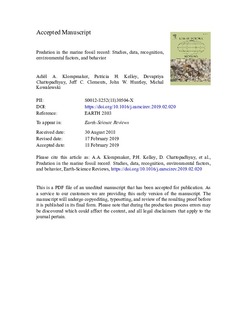| dc.description.abstract | The fossil record is the primary source of data used to study predator-prey interactions in deep time and to evaluate key questions regarding the evolutionary and ecological importance of predation. Here, we review the types of paleontological data used to infer predation in the marine fossil record, discuss strengths and limitations of paleontological lines of evidence used to recognize and evaluate predatory activity, assess the influence of environmental gradients on predation patterns, and review fossil evidence for predator behavior and prey defense. We assembled a predation database from the literature that documents a steady increase in the number of papers on predation since the 1960s. These studies have become increasingly quantitative and have expanded in focus from reporting cases of predation documented by fossils to using the fossil record of predation to test ecological and evolutionary hypotheses. The data on the fossil record of predation amassed so far in the literature primarily come from trace fossils, mostly drill holes and, to a lesser extent, repair scars, derived predominantly from the Cenozoic of Europe and North America. Mollusks are the clade most often studied as prey and inferred predators. We discuss how to distinguish biotic from abiotic damage and predatory from parasitic traces, and how to recognize failed predation. Our data show that identifying the predator is easiest when predator and prey are preserved in the act of predation or when predators were fossilized with their gut contents preserved. However, determining the culprits responsible for bite traces, drill holes, and other types of predation traces can be more problematic. Taphonomic and other factors can distort patterns of predation, but their potential effects can be minimized by careful study design. With the correct identification and quantification of fossilized traces of predation, ecological trends in predator-prey interactions may be discerned along environmental gradients in water depth, habitat, and oxygen and nutrient availability. However, so far, these trends have not been explored adequately for the fossil record. We also review the effects of climate change and ocean acidification on predator-prey interactions, but, again, few studies consider those factors from a deep-time perspective. Finally, fossils have been used successfully to infer the behavior of ancient predators and identify and interpret active and passive defense strategies employed by their prey. The marine fossil record of predation has become a major field of research over the last 50 years, but many critical gaps remain in our understanding of the evolutionary history of predator-prey interactions. | nb_NO |

